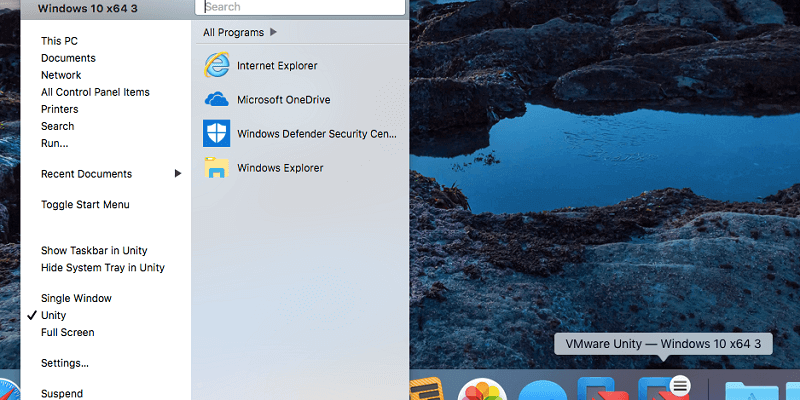
VMware Fusion
Summary
VMWare Fusion is a virtual machine software that allows you to install additional operating systems on your Mac, Windows, or Linux computer. So, for example, you can install Windows on your Mac to have access to any Windows apps you rely on.
Is it worth it? While VMware offers a 30-day free trial, which is more favorable for home users compared to Parallels Desktop, its closest competitor, in many ways, it’s less suitable for a normal home or business user. The narrower system requirements, need for support contracts and advanced features will feel more at home in a professional IT environment.
But unlike Parallels, VMware is cross-platform, and it has more features and is more responsive than the free alternatives. So if you’re an advanced user or would like to run the same virtualization solution on non-Mac computers, VMware Fusion is a strong contender.
What I Like: It runs on Mac, Windows and Linux. Unity View allows you to run Windows apps like Mac apps. You can run Linux and older versions of macOS.
What I Don’t Like: It’s more difficult to install than Parallels Desktop. No support without additional payment.
What does VMware Fusion do?
It allows you to run Windows apps on your Mac. Well, technically, Windows is running on a virtual machine, a computer emulated in software. Your virtual computer is assigned a portion of the RAM, processor, and disk space of your real computer, so it will be slower and have fewer resources.
You’re not limited to just running Windows: you can install other operating systems including Linux and macOS — including older versions of macOS and OS X. VMware Fusion requires a Mac launched in 2011 or later.
Is VMware Fusion no longer free?
VMware used to offer a free, perpetual, Personal Use license for Fusion Player. Now it seems the company has made some changes to its pricing and offers a 30-day free trial (no registration required). After day 30, you’ll need to buy a license if you want to keep using the software.
What’s the difference between VMware Fusion and Fusion Pro?
Basic features are identical for each, but the Pro version has some advanced features that may appeal to advanced users, developers, and IT professionals. These include:
- Creating linked and full clones of virtual machines
- Advanced networking
- Secure VM encryption
- Connecting to vSphere/ESXi Server
- Fusion API
- Virtual network customization and simulation.
In this review, we focus on the basic features that will be of interest to all users.
How to Install VMware Fusion on Mac?
Here is an overview of the full process of getting the app up and running. I ran into a few roadblocks, so you’ll find more detailed instructions below.
- Download and install VMware Fusion for Mac, Windows or Linux, depending on which operating system is already running on your computer.
- If you’re running macOS High Sierra, you will have to explicitly allow VMware to install system extensions in your Mac System Preferences under Security and Privacy.
- Create a new virtual machine and install Windows. You’ll need to purchase Windows if you don’t already own a copy, and install it either from an ISO disk image, a DVD, or a current install on Bootcamp or another computer. You won’t be able to install directly from a flash drive or DMG disk image.
- Install the Windows applications of your choice.
Table of Contents
Why Trust Me for This Review
My name is Adrian Try. After using Microsoft Windows for over a decade, I made a deliberate move away from the operating system to Linux in 2003 and Mac in 2009. There were still some Windows apps that I wanted to use from time to time, so I found myself using a combination of dual boot, virtualization (using VMware Player and VirtualBox), and Wine. See the “Alternatives” section of this review.
I hadn’t tried VMware Fusion before, so I installed a 30-day trial on my MacBook Air. I did try running it on my 2009 iMac, but VMware requires newer hardware. For the last week or two, I’ve been putting it through its paces, installing Windows 10 and several other operating systems, and trying just about every feature in the program.
This review reflects the Mac version of the newly-released VMware Fusion, though it’s also available for Windows and Linux. I’ll share what the software is capable of, including what I like and dislike.
Detailed Review of VMware Fusion
VMWare Fusion is all about running Windows apps (and more) on your Mac. I’ll cover its main features in the following five sections. In each subsection, I’ll first explore what the app offers and then share my personal take.
1. Turn Your Mac Into Several Computers with Virtualization
VMware Fusion is virtualization software — it emulates a new computer in software, a “virtual machine”. On that virtual computer, you can run any operating system you like, including Windows, and any software that runs on that operating system, which is especially useful if you still rely on some non-Mac software.
Of course, you could install Windows on your Mac directly — you can even have both macOS and Windows installed at the same time, and use Bootcamp to switch between them. Of course, that means rebooting your computer each time you switch, which isn’t always convenient. Running Windows in a virtual machine means you can use it at the same time as macOS.
A virtual machine will run slower than your real computer, but VMware has worked hard to optimize performance, especially when running Windows. I found VMware’s performance very snappy.
My personal take: Virtualization technology provides a convenient way of accessing non-Mac software while using macOS.
2. Run Windows on Your Mac Without Rebooting
Why run Windows on your Mac? Here are some common reasons:
- Developers can test their software on Windows and other operating systems.
- Web developers can test their websites on a variety of Windows browsers.
- Writers can create documentation and reviews about Windows software.
VMware provides the virtual machine, you need to supply Microsoft Windows. You can do that by:
- Purchasing it directly from Microsoft and downloading an .IOS disk image.
- Purchasing it from a store and install from a DVD.
- Transferring an already-installed version of Windows from your PC or Mac.
In my case, I purchased a shrink-wrapped version of Windows 10 Home (with an enclosed USB stick) from a store. The price was the same as downloading from Microsoft: $179 Aussie dollars.
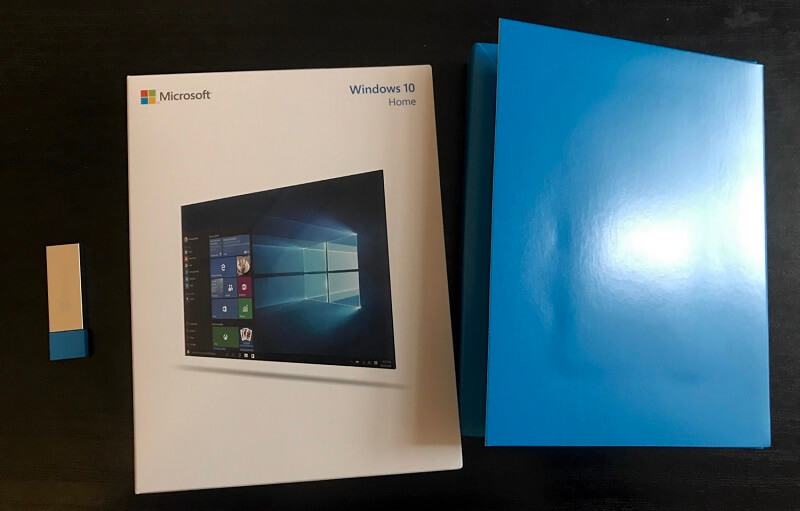
I purchased it a few months ago when evaluating one of VMware’s competitors: Parallels Desktop. While installing Windows using Parallels was a walk in the park, doing the same with VMware wasn’t so easy: I encountered some frustrating and time-consuming dead ends.
Not everyone will experience them. But VMware requires newer hardware than Parallels, and doesn’t support all of the installation options I expected, including installing from USB. If I’d downloaded Windows rather than buying a USB stick, my experience would have been very different. Here are some lessons I learned — I hope they help you to have an easier time.
- VMware Fusion will not run successfully on Macs made before 2011.
- If you encounter error messages during install, restarting your Mac may help.
- You need to allow VMware to access its system extensions in your Mac’s security settings.
- You cannot install Windows (or other operating systems) from a flash drive. The best options are DVD or ISO disk image.
- You can’t use VMware’s Windows Easy Install option on a DMG disk image created with Disk Utility. It must be an ISO disk image. And I couldn’t successfully install Windows without Easy Install — Windows couldn’t find the correct drivers.
So you’ll need to install Windows from either an installation DVD or from an ISO image downloaded from Microsoft’s website. The Windows serial number from my flash drive worked fine with the download.
Once I got the dead ends out of the way, here’s how I installed Windows using VMware Fusion:
I downloaded VMware Fusion for Mac and installed it. I was warned that macOS High Sierra’s security settings would block VMware’s system settings unless I enabled them in System Preferences.
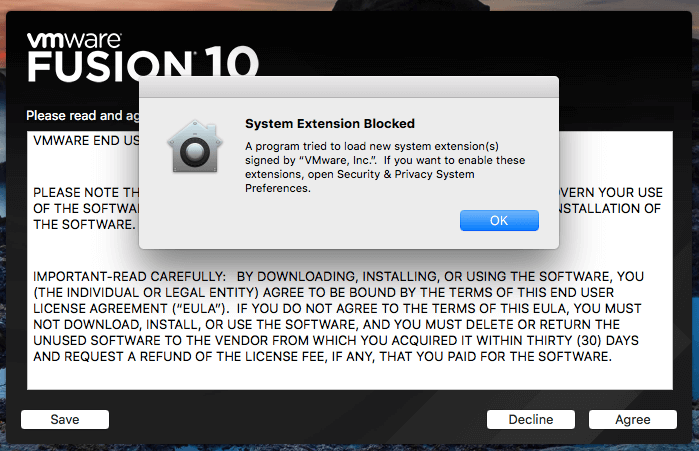
I opened the Security & Privacy System Preferences and allowed VMware to open system software.
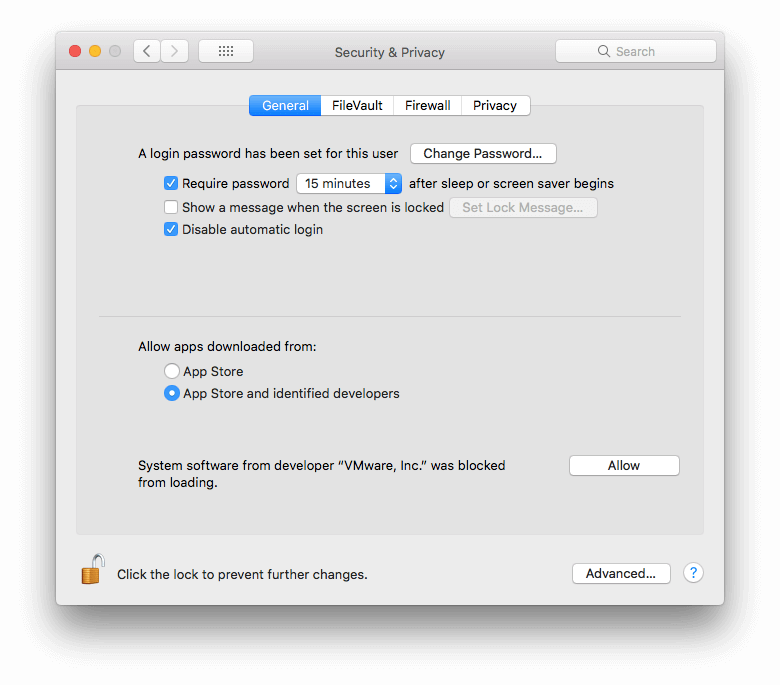
I don’t have a license for VMware Fusion, so chose the 30 day trial. I chose the version appropriate for home users. A professional version is also available.
VMware was now installed. It was time to create a virtual machine and install Windows on it. A dialog box to do this popped up automatically. During a previous installation, I restarted my Mac due to error messages. The restart helped.
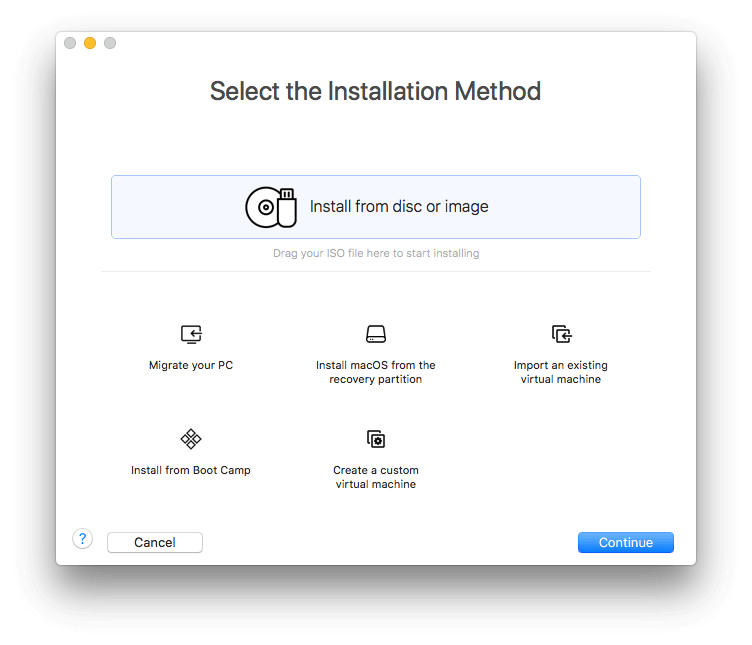
I chose the option to install from a disk image — the ISO file I downloaded from Microsoft. I dragged that file onto the dialog box and entered the Windows 10 product key I received with my installation flash drive.
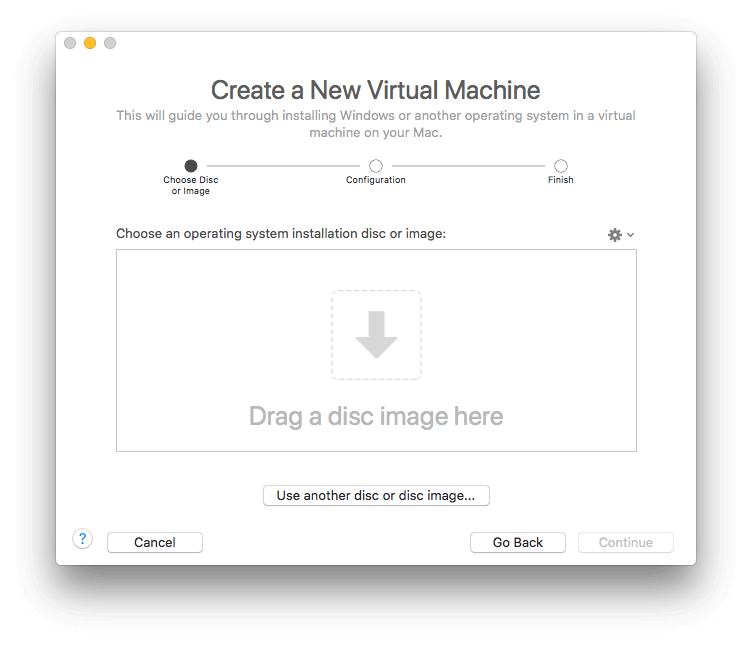
Now I was asked whether I wanted to share my Mac files with Windows, or keep the two operating systems totally separate. I chose a more seamless experience.
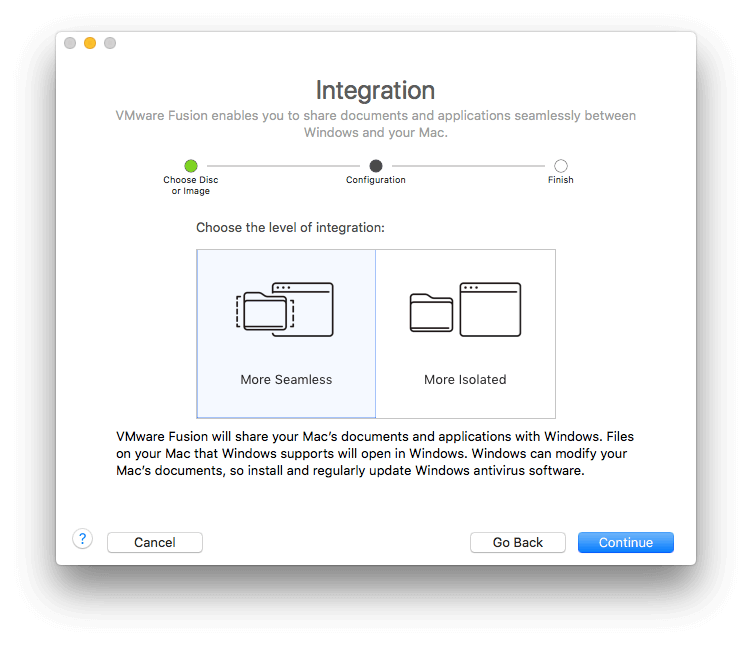
I clicked Finish, and watched Windows install.
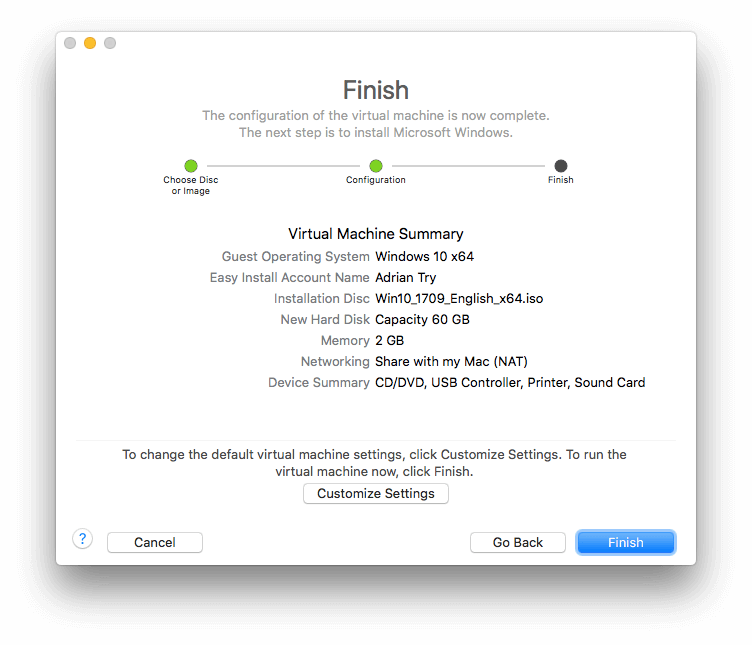
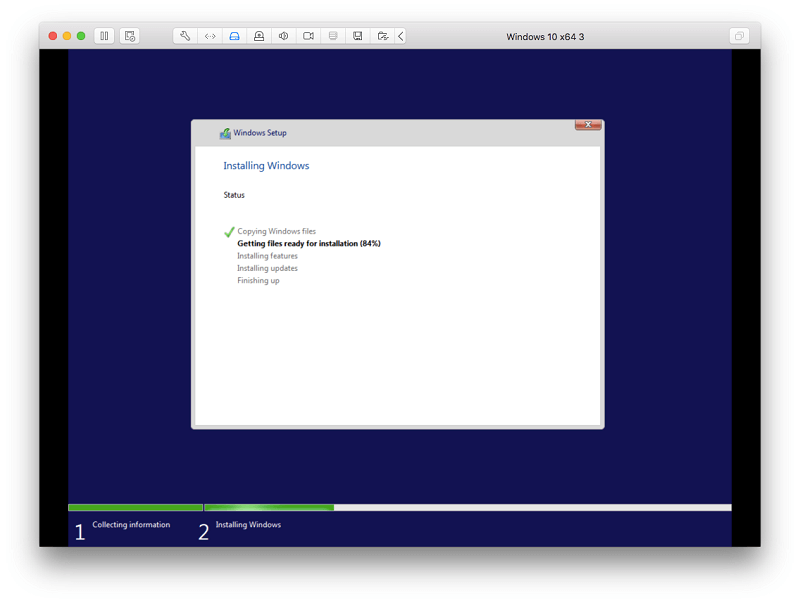
Things are going much smoother this time than previous install attempts. Even still, I hit a roadblock…
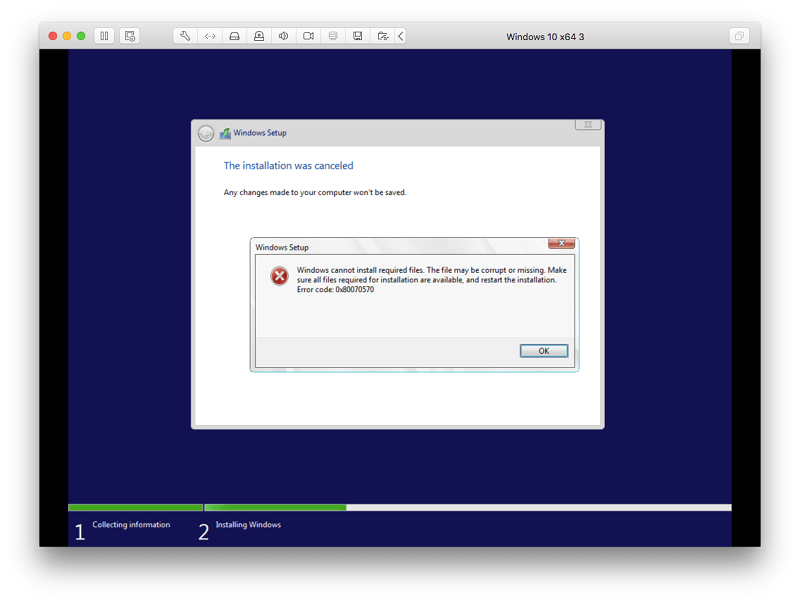
I’m not sure what happened here. I started the install again, and had no problem.
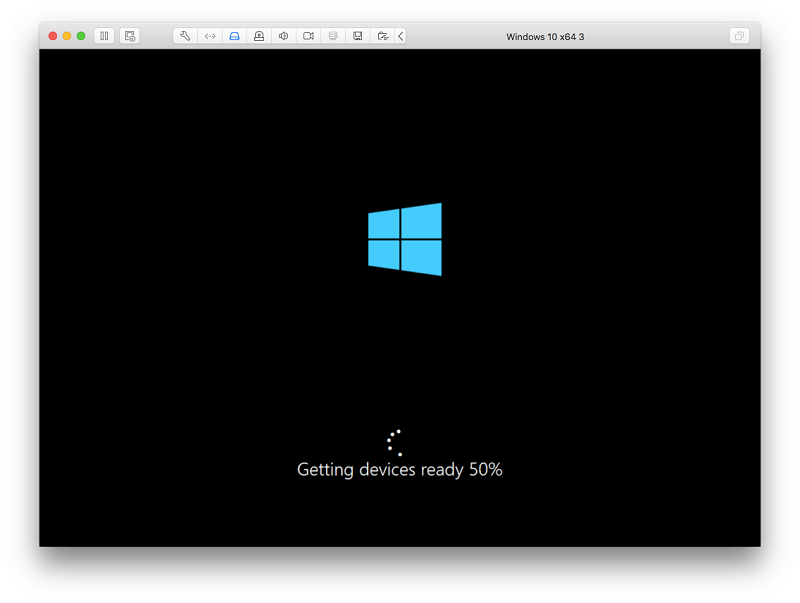
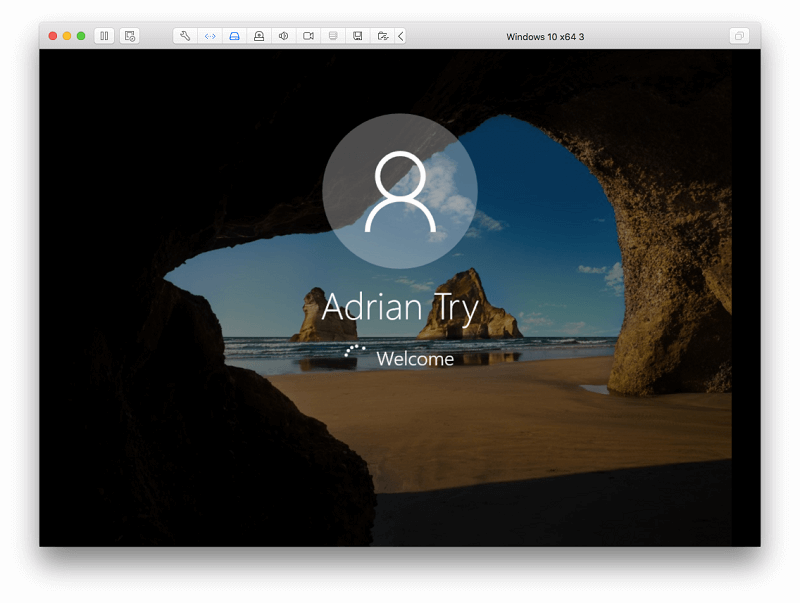
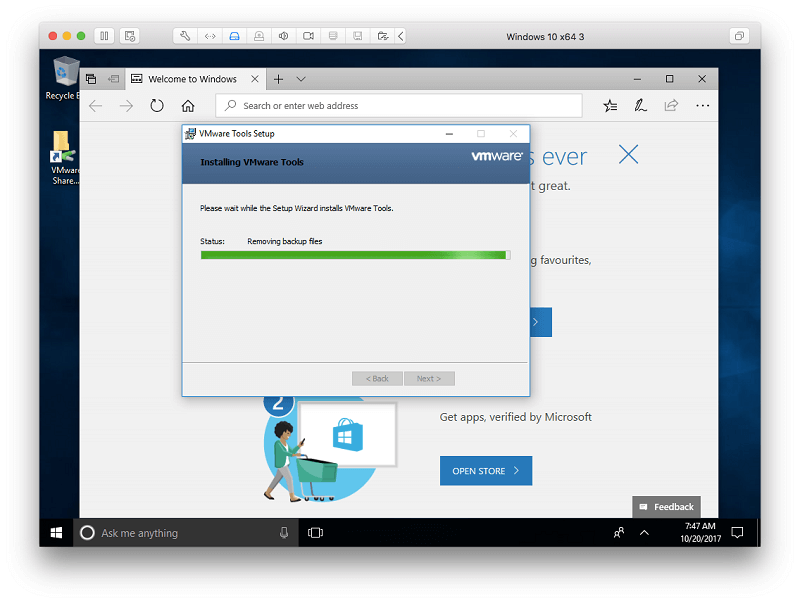
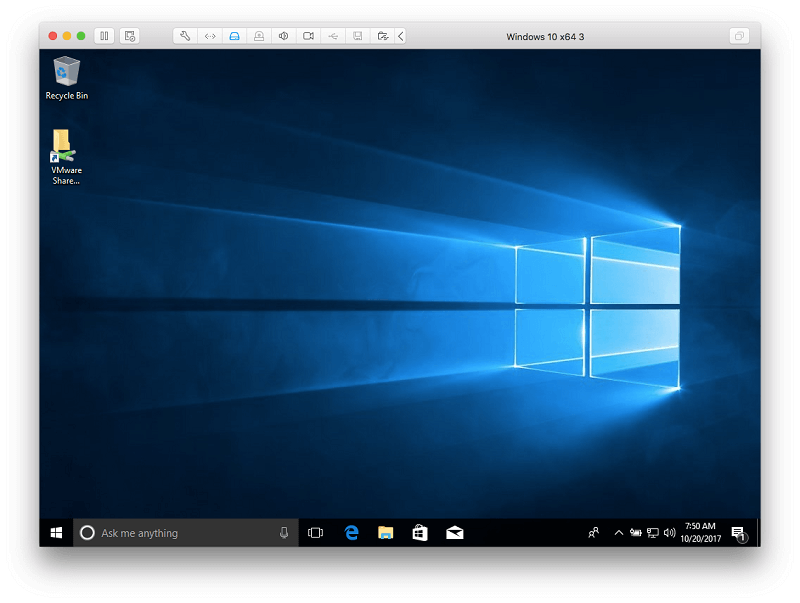
The final step was for VMware to share my Mac desktop with Windows.
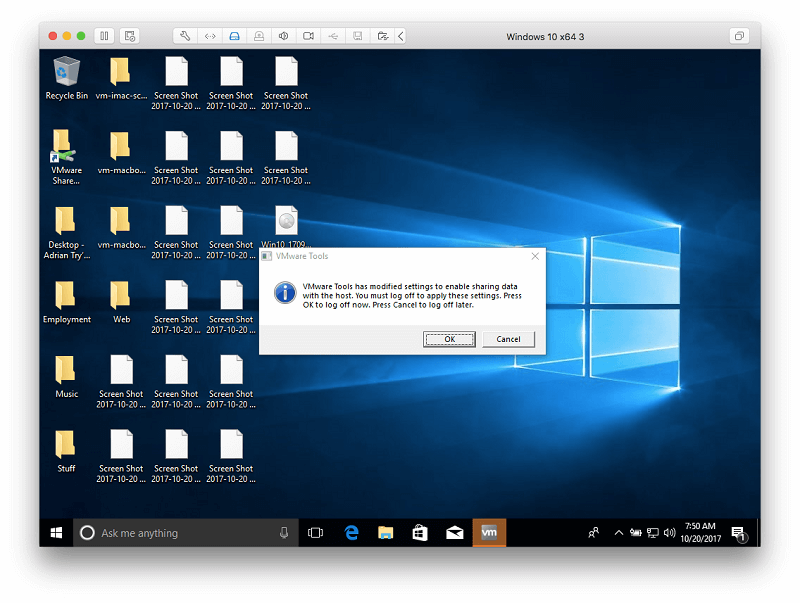
Windows is now installed and working.
My personal take: If you need to access Windows apps while using macOS, VMware Fusion is a great option. You won’t need to restart your computer, and Windows performance in a virtual machine is close to when running directly on the hardware.
3. Switch Conveniently between Mac and Windows
Switching between Mac and Windows is quick and easy using VMware Fusion. By default, it runs inside a window like this.
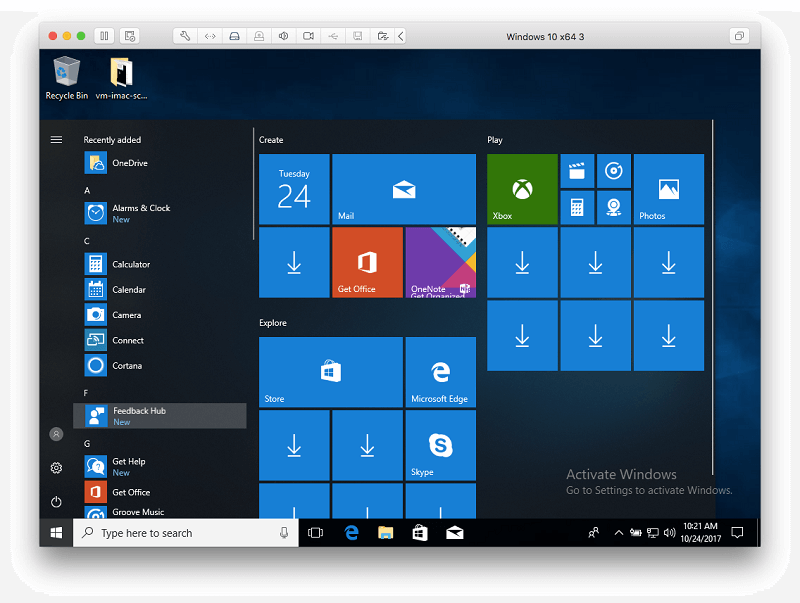
When my mouse is outside of that window, it is the black Mac mouse cursor. Once it moves inside the window, it becomes the white Windows mouse cursor automatically and instantly.
You can also run Windows full screen by pressing the Maximize button. The screen resolution is automatically adjusted to make the most of the extra space. You can switch to and from Windows using your Mac’s Spaces feature with a four-finger swipe gesture.
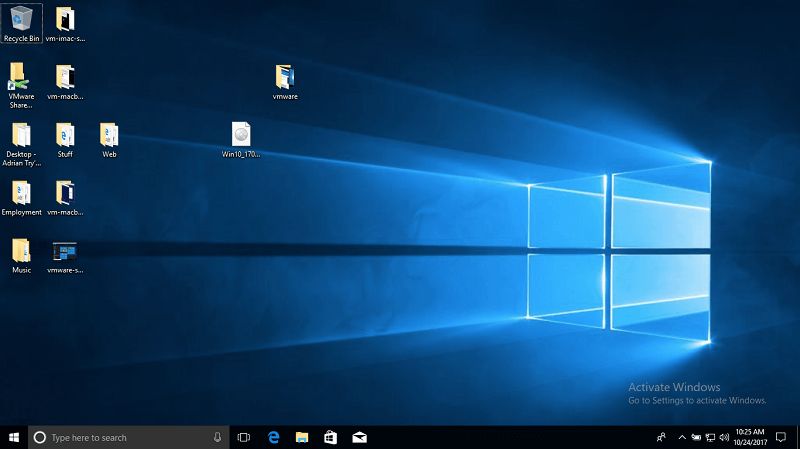
My personal take: Switching to Windows is no harder than switching to a native Mac app, whether VMware is running full-screen or in a window.
4. Use Windows Apps alongside Mac Apps
If your focus is on running Windows apps rather than Windows itself, VMware Fusion offers a Unity View that hides the Windows interface and allows you to run Windows apps as if they were Mac apps.
The Switch to Unity View button is at the top right corner of the VMware Fusion window.
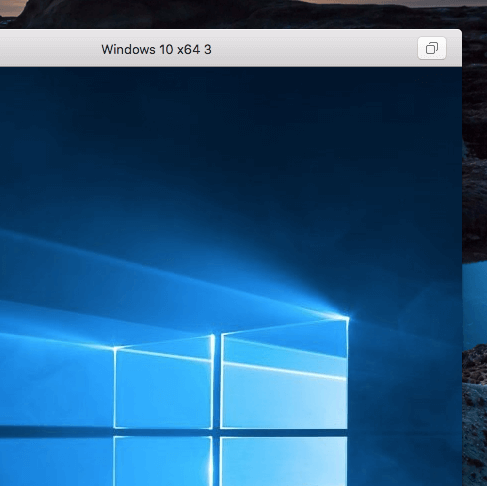
Windows vanishes. A few Windows status icons now appear on the menu bar, and clicking the VMware icon on the dock will display a Windows Start Menu.
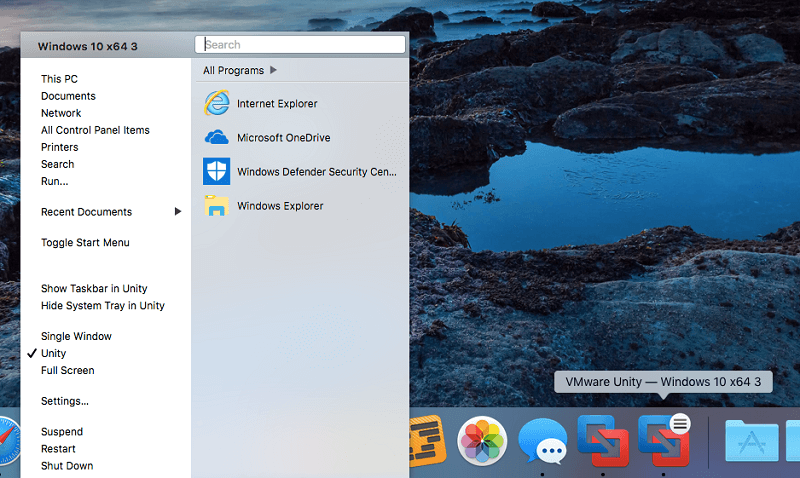
When I right-click on an icon, Windows apps appear in the Mac’s Open With menu. For example, when right-clicking on an image file, Windows Paint is now an option.
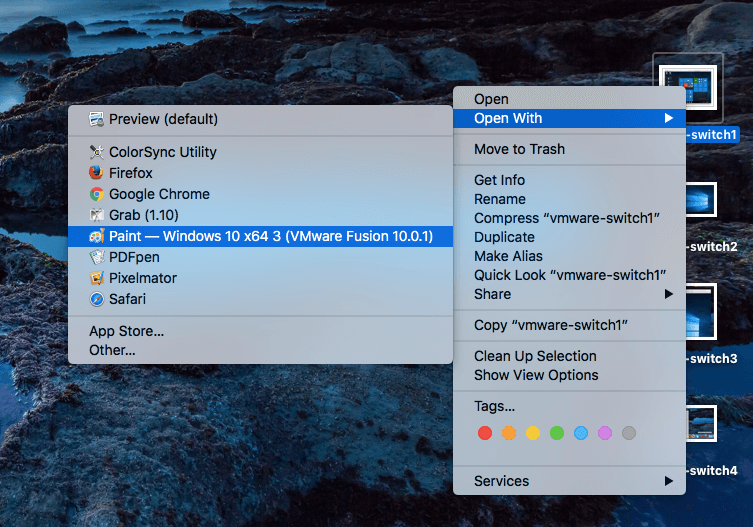
When you run Paint, it appears in its own window, like a Mac app.
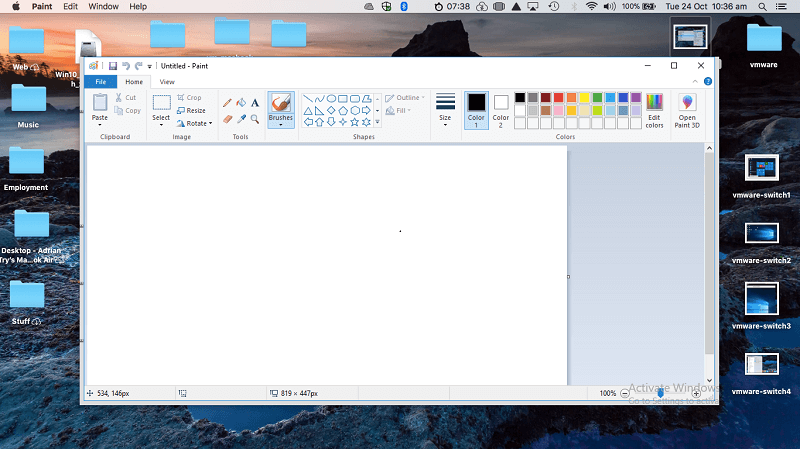
My personal take: VMware Fusion allows you to use Windows apps almost as if they were Mac apps. Using Unity View they can run in their own window, and are listed in macOS’s Open With menu when right-clicking a file.
5. Run Other Operating Systems on Your Mac
You’re not limited to running Windows on a VMware Fusion virtual computer — macOS, Linux and other operating systems can also be installed. That can be useful in situations like these:
- A developer working on an app that runs on multiple platforms can use virtual computers to run Windows, Linux and Android to test the software on.
- Mac developers can run older versions of macOS and OS X to test compatibility.
- A Linux enthusiast can run and compare multiple distros at once.
You can install macOS from your recovery partition or a disk image. You can also install older versions of OS X if you still have the installation DVDs or disk images. I chose to install macOS from my recovery partition.
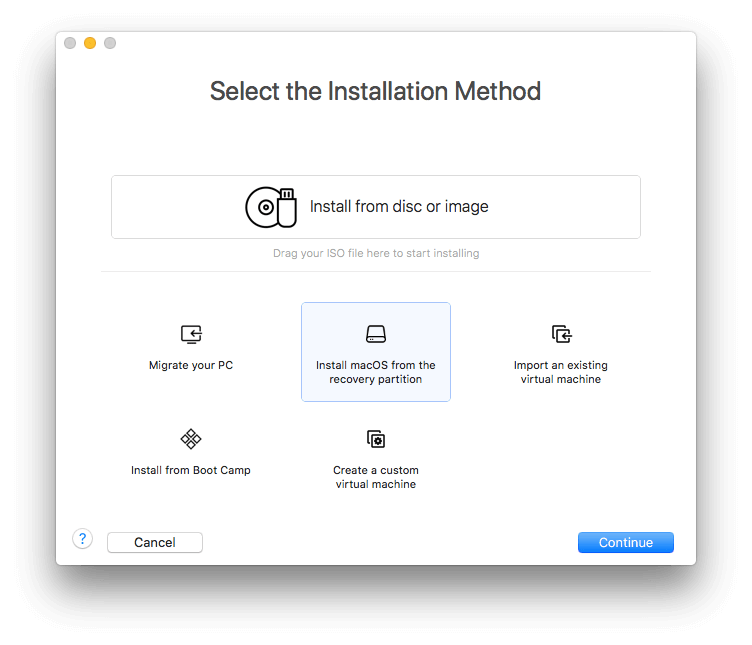
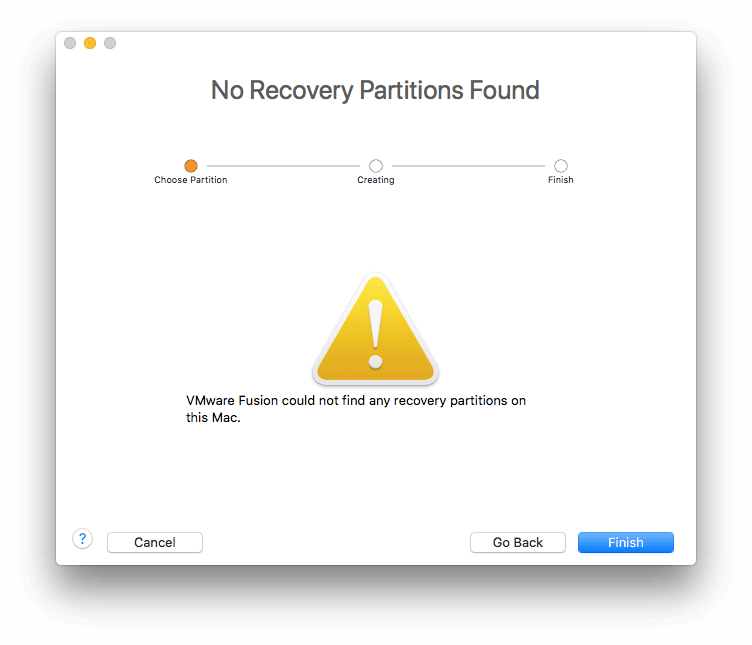
Unfortunately, there is no recovery partition on this Mac, and I don’t have a macOS disk image handy. I do have a Linux Mint installation disk image, so I tried installing that instead.
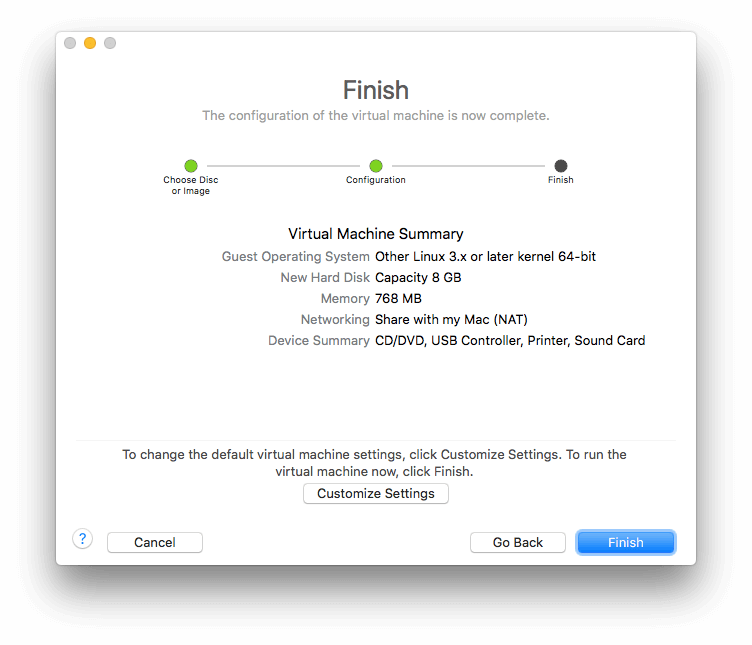
Now that the virtual machine has been created, the Linux Mint installer will boot and run.
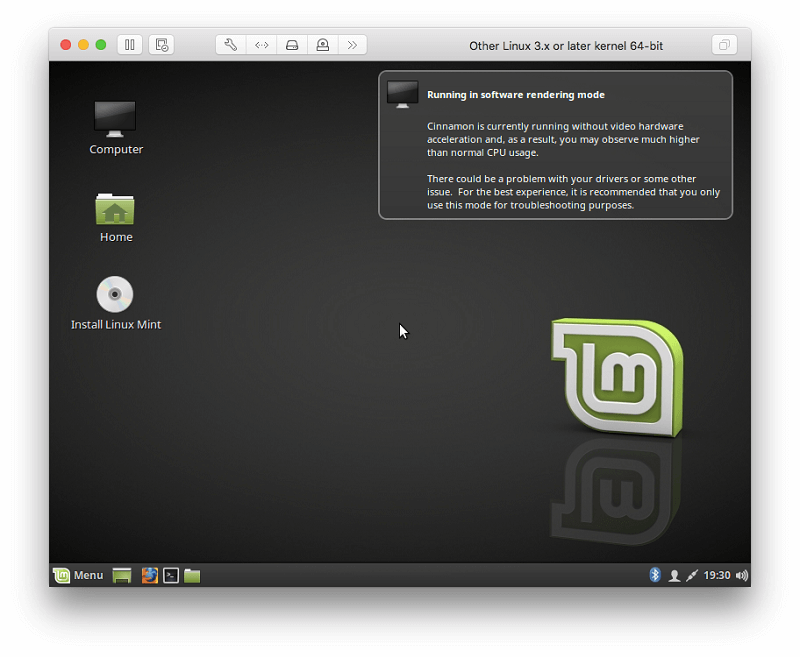
Here Linux is running from the disk image, but is not yet installed on the new virtual computer. I double click on Install Linux Mint.
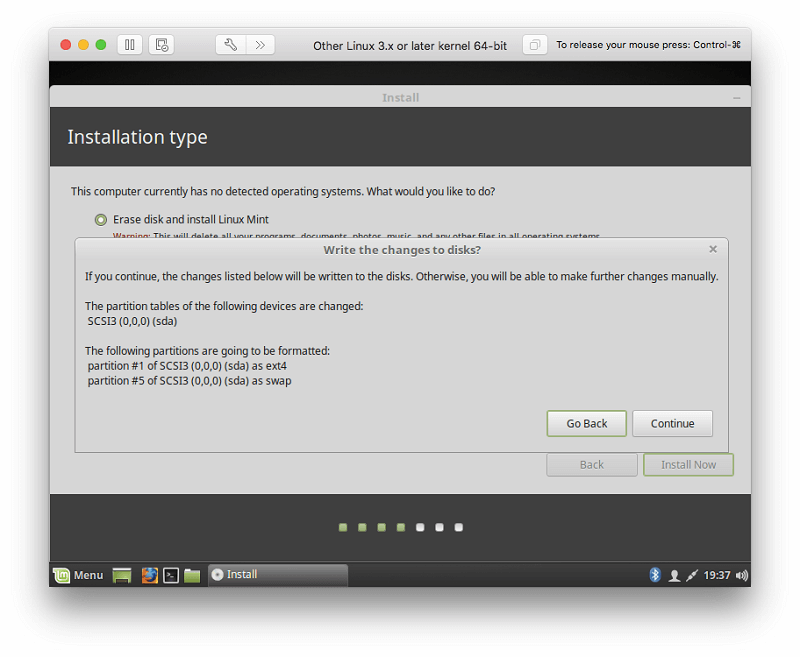
At this point, the virtual machine slowed to a crawl. I tried restarting the virtual machine, but it slowed at an even earlier point. I restarted my Mac, but no improvement. I restarted the install using a mode that uses fewer resources, and that helped. I worked through the installation to get to the same point as where we left off.
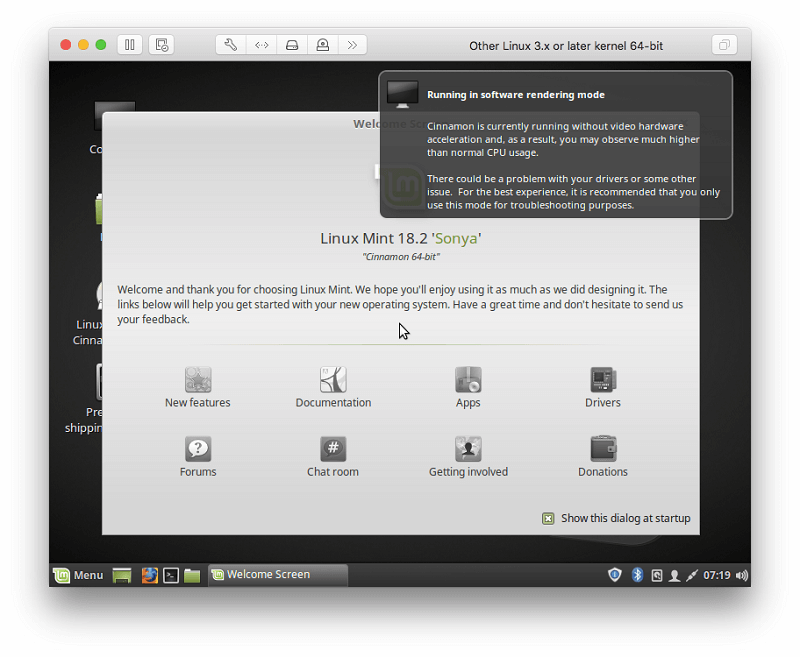
Linux is now installed. Though it’s lacking drivers to work most efficiently on VMware’s virtual hardware, performance is pretty good. VMware does provide drivers, so I try to install them.
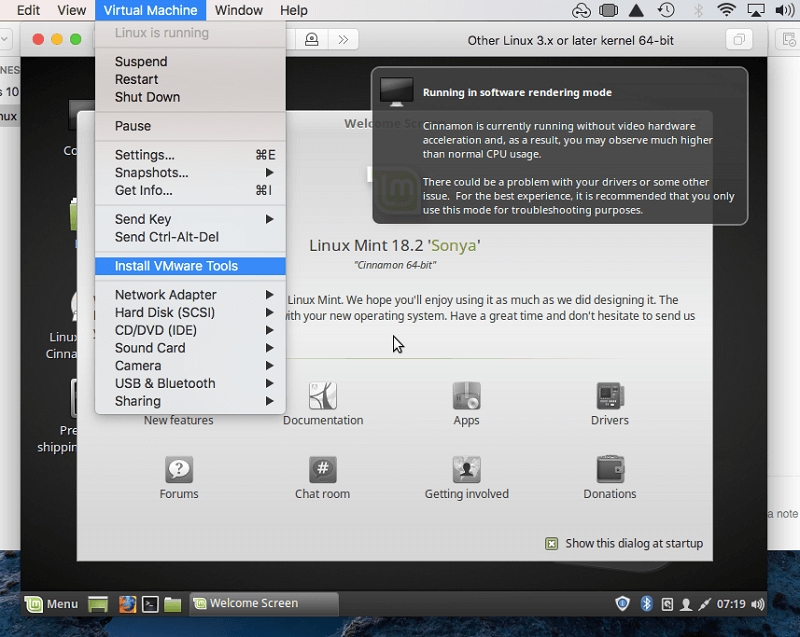
Driver installation didn’t seem successful. It would have been good if it worked first time, but if I had more time, I’m sure I could get it working. Performance is pretty good all the same, especially for apps that are not graphics intensive.
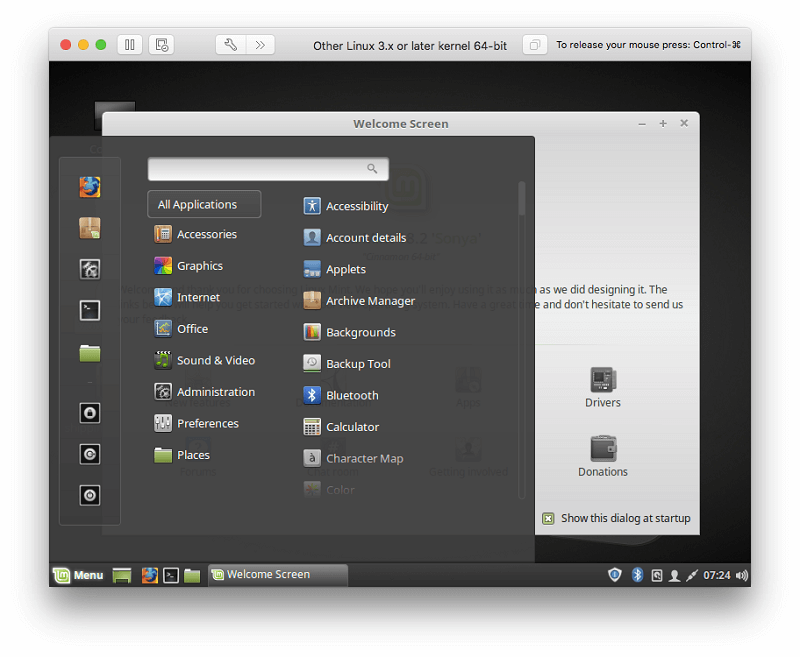
My personal take: Some users may value VMware Fusion’s ability to run other operating systems, including macOS and Linux.
The Reasons Behind My Ratings
Effectiveness: 4.5/5
Once installed, VMware Fusion effectively allows you to run Windows and other operating systems on your Mac without restarting your computer. When running Windows, extra integration features are available, allowing Windows to access your Mac files, and allowing Windows apps to run like Mac apps.
Price: 4.5/5
The basic version of VMware costs pretty much the same as Parallels Desktop, its closest competitor, though the Pro version costs more. But keep in mind that a Parallels Pro license is good for three Macs, while a VMware Fusion Pro license is for all the Macs you own, so if you have a lot of computers, VMware may be a bargain.
Ease of Use: 4/5
I took a mark off for the roadblocks I encountered when installing Windows on VMware, though not everyone will encounter the same problems I did. VMware’s system requirements and installation options are more limited than Parallels Desktop’s. Once running, though, VMware Fusion was simple to use, though not quite as easy as Parallels.
Support: 4/5
Support for VMware Fusion is not included in the purchase price, but you can purchase support on a per-incident basis. This gives you access to a technical engineer by phone and email who will respond to you within 12 business hours. Before purchasing support, VMware recommends you first explore their knowledge base, documentation, and discussion forums.
Alternatives to VMware Fusion
- Parallels Desktop is a popular virtualization platform and VMware’s closest competitor.
- VirtualBox is Oracle’s free and open-source alternative. Not as polished or responsive, it’s a good alternative when performance is not at a premium.
- Boot Camp comes installed with macOS, and allows you to run Windows alongside macOS in a dual-boot setup — to switch you need to restart your computer. That’s less convenient but has performance benefits.
- Wine is a way of running Windows apps on your Mac without needing Windows at all. It can’t run all Windows apps, and many require significant configuration. It’s a free (open source) solution that just might work for you.
- CodeWeavers CrossOver is a commercial version of Wine that is easier to use and configure.
Final Verdict
VMware Fusion runs Windows and other operating systems in virtual machines alongside your Mac apps. That’s a good thing if you rely on certain Windows apps, or if you develop apps or websites and need a testing environment.
Many home and business users will find Parallels Desktop easier to install and use, but VMware is close. Where it shines is in its advanced features, and its ability to run on Windows and Linux as well. Advanced users and IT professionals may find it a good fit for their needs.
If running Windows on your Mac is useful but non-critical, try one of the free alternatives. But if you rely on Windows software, need to run multiple operating systems, or need a stable testing environment for your apps or websites, you absolutely need the stability and performance of VMware Fusion or Parallels Desktop. Read through both reviews and choose the one that best meets your needs.
Have you tried VMware Fusion? What’s your thought about this VMware Fusion review? Leave a comment and let us know.

Great post i like it New version
Is the Fusion 10 compatible with latest MacBook Pro 2018 with T2 chips ?
Hi Adrian 😉 According to VMware, “All Macs launched in 2011 or later are supported except 2012 Mac Pro “Quad Core” using the Intel® Xeon® W3565 Processor.” So the answer would be YES.